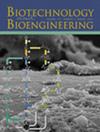中国仓鼠卵巢细胞功能增强因子的全面定位。
IF 3.6
2区 生物学
Q2 BIOTECHNOLOGY & APPLIED MICROBIOLOGY
引用次数: 0
摘要
中国仓鼠卵巢(CHO)细胞是重组治疗性蛋白生产的主要哺乳动物系统。然而,由于对CHO细胞中控制基因表达的调控机制的了解有限,优化转基因表达仍然具有挑战性。为了克服这一障碍,我们在这里提供了CHO细胞中顺式调节元件的系统表征。使用全基因组STARR-seq(一种定量增强子强度的高通量方法),我们确定了CHO细胞基因组中具有增强子活性的区域。通过将这些数据与ATAC-seq和组蛋白修饰谱相结合,我们能够表征这些区域的染色质状态。我们的分析揭示了数千个新发现的增强子序列。最活跃的序列可以驱动转基因表达,其水平与强病毒增强子相似或更高。值得注意的是,发现的具有增强子活性的区域中有一半位于其原生环境中不可接近的染色质内。我们观察到,可接近的增强子主要靠近转录起始位点,与普遍表达的基因相关,而不可接近的增强子主要是基因间的,与组织特异性基因相关。此外,通过基于深度学习的方法,ETS和YY1转录因子(TF)结合基序被确定为增强子身份和强度的关键决定因素。破坏YY1结合基序导致增强子活性降低,从而突出了YY1在CHO细胞中作为转录激活因子的重要性。我们的研究展示了CHO细胞中第一个功能验证增强子的综合图谱,并对基因调控和tf在决定增强子强度中的作用产生了新的见解。该研究有助于为CHO细胞转录网络的战略性工程奠定基础,以实现生物制药生产的增强。本文章由计算机程序翻译,如有差异,请以英文原文为准。
Comprehensive Mapping of Functional Enhancers in Chinese Hamster Ovary Cells.
Chinese hamster ovary (CHO) cells are the leading mammalian system for recombinant therapeutic protein production. However, optimizing transgene expression remains challenging due to the limited understanding of the regulatory mechanisms controlling gene expression in CHO cells. Towards overcoming this barrier, here we provide a systematic characterization of cis-regulatory elements in CHO cells. Using genome-wide STARR-seq, a high-throughput method for quantifying enhancer strength, we identified regions with enhancer activity in the CHO cell genome. By integrating these data with ATAC-seq and histone modification profiles, we were able to characterize the chromatin state of these regions. Our analysis revealed thousands of newly identified enhancer sequences. The most active sequences could drive transgene expression at levels similar to or higher than strong viral enhancers. Notably, half of the regions found to have enhancer activity were within inaccessible chromatin in their native context. We observed that accessible enhancers were primarily near to transcriptional start sites and associated with ubiquitously-expressed genes, whereas inaccessible enhancers were predominantly intergenic and associated with tissue-specific genes. Additionally, through a deep-learning-based approach ETS and YY1 transcription factor (TF) binding motifs were identified as key determinants of enhancer identity and strength. Disrupting YY1 binding motifs led to reduced enhancer activity, thereby highlighting the importance of YY1 as a transcriptional activator in CHO cells. Our study demonstrates the first comprehensive map of functionally-validated enhancers in CHO cells and generates new insights into gene regulation and the role of TFs in determining enhancer strength. This study helps to lay the foundation for strategic engineering of CHO cell transcriptional networks to achieve enhanced biopharmaceutical production.
求助全文
通过发布文献求助,成功后即可免费获取论文全文。
去求助
来源期刊

Biotechnology and Bioengineering
工程技术-生物工程与应用微生物
CiteScore
7.90
自引率
5.30%
发文量
280
审稿时长
2.1 months
期刊介绍:
Biotechnology & Bioengineering publishes Perspectives, Articles, Reviews, Mini-Reviews, and Communications to the Editor that embrace all aspects of biotechnology. These include:
-Enzyme systems and their applications, including enzyme reactors, purification, and applied aspects of protein engineering
-Animal-cell biotechnology, including media development
-Applied aspects of cellular physiology, metabolism, and energetics
-Biocatalysis and applied enzymology, including enzyme reactors, protein engineering, and nanobiotechnology
-Biothermodynamics
-Biofuels, including biomass and renewable resource engineering
-Biomaterials, including delivery systems and materials for tissue engineering
-Bioprocess engineering, including kinetics and modeling of biological systems, transport phenomena in bioreactors, bioreactor design, monitoring, and control
-Biosensors and instrumentation
-Computational and systems biology, including bioinformatics and genomic/proteomic studies
-Environmental biotechnology, including biofilms, algal systems, and bioremediation
-Metabolic and cellular engineering
-Plant-cell biotechnology
-Spectroscopic and other analytical techniques for biotechnological applications
-Synthetic biology
-Tissue engineering, stem-cell bioengineering, regenerative medicine, gene therapy and delivery systems
The editors will consider papers for publication based on novelty, their immediate or future impact on biotechnological processes, and their contribution to the advancement of biochemical engineering science. Submission of papers dealing with routine aspects of bioprocessing, description of established equipment, and routine applications of established methodologies (e.g., control strategies, modeling, experimental methods) is discouraged. Theoretical papers will be judged based on the novelty of the approach and their potential impact, or on their novel capability to predict and elucidate experimental observations.
 求助内容:
求助内容: 应助结果提醒方式:
应助结果提醒方式:


